戴炜栋《新编简明英语语言学教程》笔记和课后习题(含考研真题)详解(语言习得)【圣才出品】
戴炜栋《新编简明英语语言学教程》笔记和课后习题(含考研真题)详解(第二语言习得)【圣才】
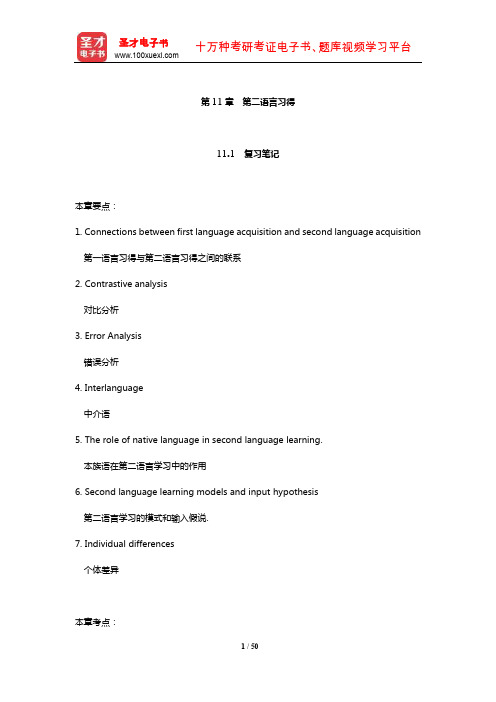
第一语言习得与第二语言习得之间的联系 2. Contrastive analysis
对比分析 3. Error Analysis
错误分析 4. Interlanguage
中介语 5. The role of native language in second language learning.
本族语在第二语言学习中的作用 6. Second language learning models and input hypothesis
1. Overgeneralization 2. Cross-association V. Interlanguage VI. The role of native language in second language learning VII. Second language learning models and input hypothesis VIII. Individual differences 1. Language aptitudes 2. Motivation 3. Learning strategies 4. Age of acquisition 5. Personality IX. Second language acquisition and its pedagogical implications
第二语言习得(SLA )在二十世纪七十年代左右被正式确立为一门学科,是指对一个人习 得其母语之后如何习得一门第二语言的系统研究。
戴炜栋《新编简明英语语言学教程》章节题库(第二语言习得) 【圣才出品】

第11章第二语言习得I. Multiple choices:1. ______ is defined as a conscious process of accumulating knowledge of a second language usually obtained in school settings.A. AcquisitionB. LearningC. StudyingD. Acquirement【答案】B【解析】儿童在自然环境中无意识的习得第一语言的过程被语言学家称为语言习得(acquisition),而在非自然环境下(如学校教育)经过有意识的努力学习第二语言的过程则被称为语言学习(learning)。
因此,本题的正确答案为B。
2. The distinction between acquisition and learning is put forward by ______.A. ChomskyB. KrashenC. SaussureD. Bloomfield【答案】B【解析】语言习得(acquisition)和语言学习(learning)这两个概念是由美国学者Stephen Krashen提出来的,以区分这两个过程之间的差异。
因此,本题的正确答案为B。
3. L2 learners will subconsciously use their L1 knowledge in learning a second language. This is known as______.A. language interferenceB. language fossilizationC. contrastive analysisD. language transfer【答案】D【解析】在学习第二语言时, 学习者会无意识地运用他们的一语知识,这是一种非常自然的现象,这种现象被语言学家称为语言的转移(language transfer)。
戴炜栋《新编简明英语语言学教程》(第2版)课后习题详解(下)【圣才出品】
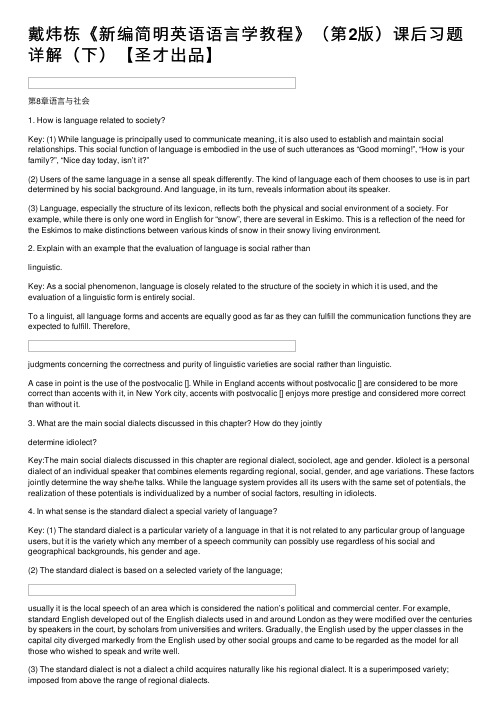
戴炜栋《新编简明英语语⾔学教程》(第2版)课后习题详解(下)【圣才出品】第8章语⾔与社会1. How is language related to society?Key: (1) While language is principally used to communicate meaning, it is also used to establish and maintain social relationships. This social function of language is embodied in the use of such utterances as “Good morning!”, “How is your family?”, “Nice day today, isn’t it?”(2) Users of the same language in a sense all speak differently. The kind of language each of them chooses to use is in part determined by his social background. And language, in its turn, reveals information about its speaker.(3) Language, especially the structure of its lexicon, reflects both the physical and social environment of a society. For example, while there is only one word in English for “snow”, there are several in Eskimo. This is a reflection of the need for the Eskimos to make distinctions between various kinds of snow in their snowy living environment.2. Explain with an example that the evaluation of language is social rather thanlinguistic.Key: As a social phenomenon, language is closely related to the structure of the society in which it is used, and the evaluation of a linguistic form is entirely social.To a linguist, all language forms and accents are equally good as far as they can fulfill the communication functions they are expected to fulfill. Therefore,judgments concerning the correctness and purity of linguistic varieties are social rather than linguistic.A case in point is the use of the postvocalic []. While in England accents without postvocalic [] are considered to be more correct than accents with it, in New York city, accents with postvocalic [] enjoys more prestige and considered more correct than without it.3. What are the main social dialects discussed in this chapter? How do they jointlydetermine idiolect?Key:The main social dialects discussed in this chapter are regional dialect, sociolect, age and gender. Idiolect is a personal dialect of an individual speaker that combines elements regarding regional, social, gender, and age variations. These factors jointly determine the way she/he talks. While the language system provides all its users with the same set of potentials, the realization of these potentials is individualized by a number of social factors, resulting in idiolects.4. In what sense is the standard dialect a special variety of language?Key: (1) The standard dialect is a particular variety of a language in that it is not related to any particular group of language users, but it is the variety which any member of a speech community can possibly use regardless of his social and geographical backgrounds, his gender and age.(2) The standard dialect is based on a selected variety of the language;usually it is the local speech of an area which is considered the nation’s political and commercial center. For example, standard English developed out of the English dialects used in and around London as they were modified over the centuries by speakers in the court, by scholars from universities and writers. Gradually, the English used by the upper classes in the capital city diverged markedly from the English used by other social groups and came to be regarded as the model for all those who wished to speak and write well.(3) The standard dialect is not a dialect a child acquires naturally like his regional dialect. It is a superimposed variety; imposed from above the range of regional dialects.(4) The standard dialect has some special functions. Also designated as the official or national language of a country, the standard dialect is used for such official purpose as government documents, education, news reporting; it is the language used on any formal occasions.5. What is register as used by Halliday? Illustrate it with an example of your own. Key: According to Halliday, “Language varies as its function varies; it differs in different situations.” The type of language which is selected as appropriate to the type of situation is a register. Halliday further distinguishes three social variables that determine the register: field of discourse, tenor of discourse, and mode of discourse.For example, a lecture on biology in a technical college could be identifiedas:Field: scientific (biological)Tenor: teacher-students (formal, polite)Mode: oral (academic lecturing)6. What linguistic features of Black English do you know? Do you think Black English is an illogical and inferior variety of English? Why (not)?Key: (1) Linguistic features of Black English:Phonological features: simplification of consonant clusters at the end of a word. According to this consonant deletion rule, the final-position consonants are often deleted; thus “passed” is often pronounced [], mend [], desk [], and told [].Syntactic features one: the deletion of link verb “be”. In Black English, we often come across many sentences without copula verb: “They mine”, “You crazy”, “Her hands cold”, and “That house big”. In fact, copula verb deletion is not a unique feature of Black English, it is often found in other dialects of English and in languages like Russian and Chinese.Syntactic features two: the use of double negation structure. e.g.He don’t know nothing. (He doesn’t know anything.)I ain’t afraid of no ghosts. (I am not afraid of ghosts.)Some people consider these sentences illogical because they claim that two negatives make positive. But in fact, such double negative constructions werefound in all dialects of English of earlier period.(2) I don’t think Black English is an illogical and inferior variety of English.Linguists are agreed that no variety of a language is inherently better than any other. They insist that all languages and all varieties of a particular language are equal in that they quite adequately serve the needs of those who use them. The only exception they recognize are pidgins, which are by definition restricted varieties, or the varieties we associate with people who are impaired in some way, e.g. certain mentally or physically handicapped people. American English is considered “better”only in a social sense: it has a preferred status; it gives those who use it certain social advantages; and it increases their life chances. Black English, being a nonstandard variety, tends to produce the opposite effect. These are some of the consequences that follow from elevating one variety and denigrating others, but there is no reason to suppose that any one of the varieties is intrinsically more worthy than any other.7. What peculiar features does pidgin have?Key: A pidgin is a special language variety that mixes or blends languages and it is used by people who speak different languages for restricted purposes such as trading. Pidgin arose from a blending of several languages such as Chinese dialects and English, African dialects and French. Usually a European language serves as the basis of the pidgin in the sense that some of its grammar and vocabulary is derived from the European language used by traders andmissionaries. Pidgins typically have a limited vocabulary and a reduced grammatical structure characterized by the loss ofinflection, gender and case. The “simplified” variety performs its function as trading and employment.8. How do bilingualism and diglossia differ, and what do they have in common? Key: Differences:(1)Bilingualism refers to the situation that two languages are used side by side with each having a different role to play; and language switching occurs when the situation changes.(2)Diglossia, refers to a sociolinguistic situation similar to bilingualism. In a diglossic situation, two varieties (high variety and low variety) of a language, instead of two different languages, exist side by side throughout the community, with each having a definite role to play. One of the most important features of diglossia is the specialization of function of the two varieties. Each variety is the appropriate language for certain situations with very slight overlappings.Similarity:The two languages of bilingualism and two varieties of diglossia exist side by side and have different role to play as situation changes.。
戴炜栋《新编简明英语语言学教程》笔记和课后习题(含考研真题)详解(音位学)【圣才出品】
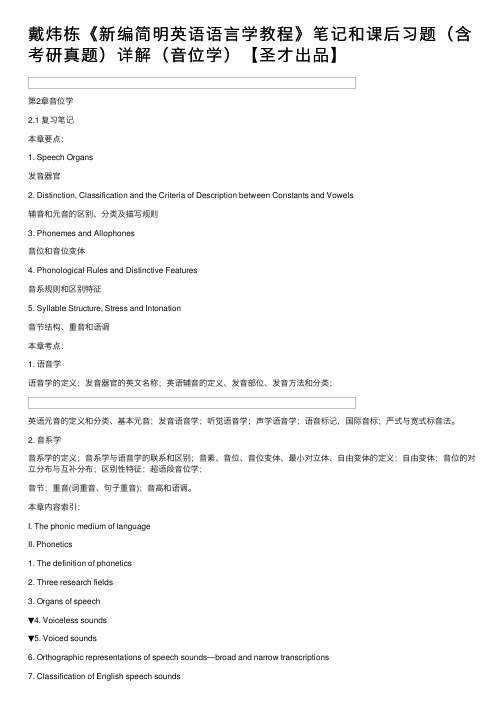
戴炜栋《新编简明英语语⾔学教程》笔记和课后习题(含考研真题)详解(⾳位学)【圣才出品】第2章⾳位学2.1 复习笔记本章要点:1. Speech Organs发⾳器官2. Distinction, Classification and the Criteria of Description between Constants and Vowels辅⾳和元⾳的区别、分类及描写规则3. Phonemes and Allophones⾳位和⾳位变体4. Phonological Rules and Distinctive Features⾳系规则和区别特征5. Syllable Structure, Stress and Intonation⾳节结构、重⾳和语调本章考点:1. 语⾳学语⾳学的定义;发⾳器官的英⽂名称;英语辅⾳的定义、发⾳部位、发⾳⽅法和分类;英语元⾳的定义和分类、基本元⾳;发⾳语⾳学;听觉语⾳学;声学语⾳学;语⾳标记,国际⾳标;严式与宽式标⾳法。
2. ⾳系学⾳系学的定义;⾳系学与语⾳学的联系和区别;⾳素、⾳位、⾳位变体、最⼩对⽴体、⾃由变体的定义;⾃由变体;⾳位的对⽴分布与互补分布;区别性特征;超语段⾳位学;⾳节;重⾳(词重⾳、句⼦重⾳);⾳⾼和语调。
本章内容索引:I. The phonic medium of languageII. Phonetics1. The definition of phonetics2. Three research fields3. Organs of speech▼4. Voiceless sounds▼5. Voiced sounds6. Orthographic representations of speech sounds—broad and narrow transcriptions7. Classification of English speech sounds(1) Definition(2) Classification of English consonants(3) Classification of English vowelsIII. Phonology1. Relationship between Phonology and phonetics2. Phone, phoneme3. Allophone4. Some rules in phonology(1) Sequential rules(2) Assimilation rule(3) Deletion rule5. Supra-segmental features—stress, tone, intonation(1) Stress(2) Tone(3) IntonationI. The phonic medium of language(语⾔的语⾳媒介)II. Phonetics(语⾳学)1. The definition of phonetics(语⾳学的定义)Phonetics is defined as the study of the phonic medium of language; it is concerned with all the sounds that occur in the world’s languages.语⾳学被定义为对语⾔的语⾳媒介的研究;它涉及所有出现在世界语⾔中的声⾳。
戴炜栋《新编简明英语语言学教程》(第2版)笔记和课后习题(含考研真题)详解(第7章 语言变化——第9
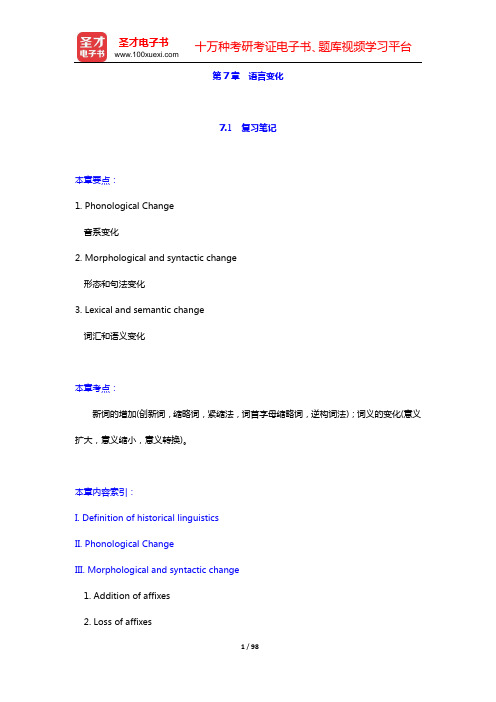
第7章语言变化7.1 复习笔记本章要点:1. Phonological Change音系变化2. Morphological and syntactic change形态和句法变化3. Lexical and semantic change词汇和语义变化本章考点:新词的增加(创新词,缩略词,紧缩法,词首字母缩略词,逆构词法);词义的变化(意义扩大,意义缩小,意义转换)。
本章内容索引:I. Definition of historical linguisticsII. Phonological ChangeIII. Morphological and syntactic change1. Addition of affixes2. Loss of affixes3. Chang of word order4. Chang in negation ruleIV. Lexical and semantic change1. Addition of new words(1) Coinage(2) Clipped words(3) Blending(4) Acronyms(5) Back-formation(6) Functional shift(7) Borrowing2. Loss of words3. Semantic Changes(1) Semantic broadening(2) Semantic Narrowing(3) Semantic shiftV. Some recent trends1. Moving towards greater informality2. The influence of American English3. The influence of science and technology(1) Space travel(2) Computer and internet language(3) EcologyVI. Causes of language changeI. Definition of historical linguistics(历史语言学的定义)Historical linguistics, as a branch of linguistics, is mainly concerned with both the description and explanation of language changes that occurred over time.历史语言学是语言学的一个分支,主要研究语言随着时间的变化而产生的变化与变化的原因。
戴炜栋《新编简明英语语言学教程》笔记和课后习题(含考研真题)详解(形态学)【圣才】
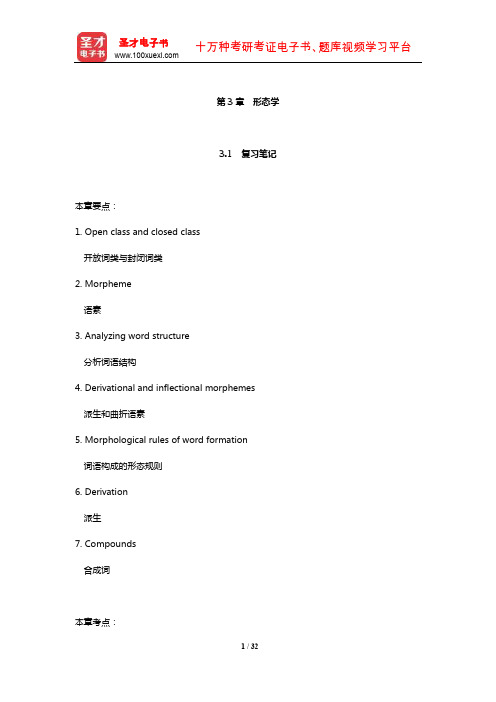
Morphology studies the internal structure of words, and the rules by which
2 / 32
圣才电子书 十万种考研考证电子书、题库视频学习平台Байду номын сангаас
圣才电子书 十万种考研考证电子书、题库视频学习平台
第 3 章 形态学
3.1 复习笔记
本章要点: 1. Open class and closed class
开放词类与封闭词类 2. Morpheme
语素 3. Analyzing word structure
分析词语结构 4. Derivational and inflectional morphemes
words are formed, including inflection and word formation. 形态学研究词的内部结构以及构词规则,包括屈折变化和构词法两个领域。
II. Open class and closed class(开放类和封闭类) 1. Open class words: in English, nouns, verbs, adjectives and adverbs make up the largest part of the vocabulary. They are the content words of a language. 开放性词类:在英语中,名词、动词、形容词和副词占词汇的绝大部分。它们是一门语 言中的实义词,经常有新词产生。 2. Closed class words: The other syntactic categories include “grammatical” or “functional” words. Conjunctions, prepositions, articles and pronouns consist of relatively few words and new words are not usually added to them. 封闭性词类:其他的句法范畴包括“语法性的”或者“功能性的”词。连词、介词、冠 词和代词相对较少,通常不会增加新词。
戴炜栋《新编简明英语语言学教程》(第2版)笔记和课后习题(含考研真题)详解(第10章 语言习得——第
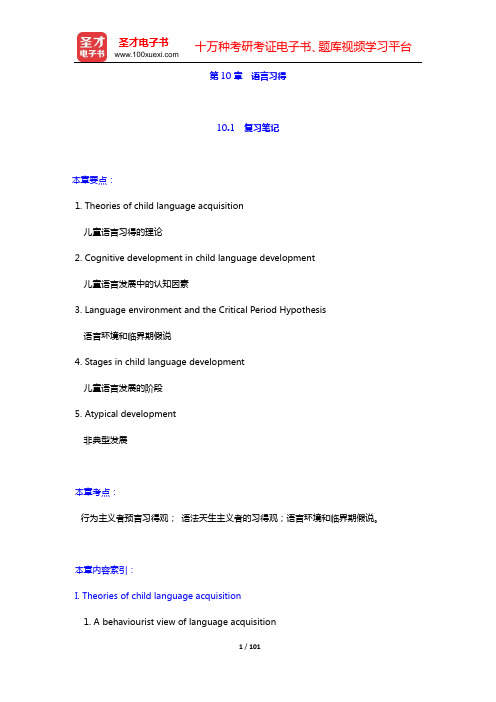
第10章语言习得10.1 复习笔记本章要点:1. Theories of child language acquisition儿童语言习得的理论2. Cognitive development in child language development儿童语言发展中的认知因素3. Language environment and the Critical Period Hypothesis语言环境和临界期假说4. Stages in child language development儿童语言发展的阶段5. Atypical development非典型发展本章考点:行为主义者预言习得观;语法天生主义者的习得观;语言环境和临界期假说。
本章内容索引:I. Theories of child language acquisition1. A behaviourist view of language acquisition2. An innatist view of language acquisition3. An interactionist view of language acquisitionII. Cognitive development in child language developmentIII. Language environment and the Critical Period HypothesisIV. Stages in child language development1. Phonological development2. Vocabulary development3. Grammatical development4. Pragmatic developmentV. Atypical developmentI. Theories of child language acquisition(儿童语言习得的理论)1. A behaviourist view of language acquisition(行为主义者的语言习得观)(1) Main content(主要观点)①A behaviourist view of language acquisition Traditional behaviorists view language as behavior and believe that language learning is simply a matter of imitation and habit formation. A child imitates the sounds and patterns of the people around him; people recognize the child’s attempts and reinforce the attempts by responding differently, the child repeats the right sounds or patterns to get the reward(reinforcement)②So imitation and practice are preliminary, discrimination and generalization are key to language development in this theory. Imitation: word for word repetitionof all or part of an utterance.①传统的行为主义者把语言看作是行为,并且相信语言学习仅仅只是一个模仿和习惯形成的问题。
戴炜栋《新编简明英语语言学教程》笔记和课后习题(含考研真题)详解-第3~5章【圣才出品】
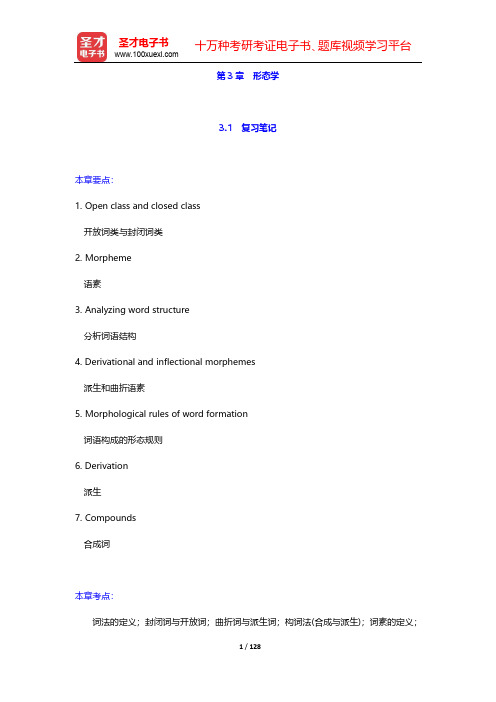
派生和曲折诧素 5. Morphological rules of word formation
词诧构成的形态觃则 6. Derivation
派生 7. Compounds
合成词
本章考点: 词法的定义;封闭词不开放词;曲折词不派生词;构词法(合成不派生);词素的定义;
1 / 128
圣才电子书 十万种考研考证电子书、题库规频学习平台
IV. Analyzing Word Structure(分析词汇结构) 1. Roots: constitute the core of the word and carries the major component of its
2 / 128
圣才电子书 十万种考研考证电子书、题库规频学习平台
形态学研究词的内部结构以及构词觃则,包括屈折变化和构词法两个领域。
II. Open class and closed class(开放类和封闭类) 1. Open class words: in English, nouns, verbs, adjectives and adverbs make up the largest part of the vocabulary. They are the content words of a language. 开放性词类:在英诧中,名词、动词、形容词和副词占词汇的绝大部分。它们是一门诧 言中的实义词,经常有新词产生。 2. Closed class words: The other syntactic categories include “grammatical” or “functional” words. Conjunctions, prepositions, articles and pronouns consist of relatively few words and new words are not usually added to them. 封闭性词类:其他的句法范畴包括“诧法性的”戒者“功能性的”词。连词、介词、冠 词和代词相对较少,通常丌会增加新词。
戴炜栋《新编简明英语语言学教程》(第2版)课后习题详解(中)【圣才出品】

戴炜栋《新编简明英语语⾔学教程》(第2版)课后习题详解(中)【圣才出品】第4章句法学1. What is syntax?Key: Syntax is a branch of linguistics that studies the rules that governs the formation of sentences.2. What is phrase structure rule?Key: The special type of grammatical mechanism that regulates the arrangement of elements that make up a phrase is calleda phrase structure rule.3. What is category? How to determine a word’s category?Key: Category refers to a group of linguistic items which fulfill the same or similar functions in a particular language such as a sentence, a noun phrase or a verb. T o determine a word’s category, three criteria are usually employed, namely, meaning, inflation and distribution.4. What is coordinate structure? What properties does it have?Key: The structures that are formed by joining two or more elements of the same type with the help of a conjunction are called coordinate structures. It has four properties: first, there is no limit on the number of coordinated categories. Second, a category at any level can be coordinated. Third, coordinated categories must be of the same type. Fourth, the category type of the coordinate phrase isidentical to the category type of the elements being conjoined.5. What elements does a phrase contain and what rule does each element play? Key: The phrase elements are specifiers, complements and modifiers. Specifiers help make more precise the meaning of the head. They typically mark a phrase. The complements provide information about entities and locations whose existence is implied by the meaning of the head. Modifiers specifies optionally expressible properties of heads.6. What is deep structure and what is surface structure?Key: The structure that formed by the XP rule in accordance with the head’s subcategorization properties is called the deep structure. The structure that corresponds to the final syntactic form of the sentence which results from appropriate transformation is called surface structure.7. Indicate the category of each word in the following sentences.a) The old lady got off the bus carefully.b) The car suddenly crashed onto the river bank.c) The blinding snowstorm might delay the opening of the school.d) This cloth feels quite soft.Key:8. The following phrases include a head, a complement, and a specifier. Draw the appropriate tree structure for each.a) rich in mineralsb) often read detective storiesc) an augment against the proposalsd) already above the windowKey: a) rich in mineralsb) often read detective storiesc) the argument against the proposalsd) already above the window9. The following sentences contain modifiers of various types. For each sentence, first identify the modifier(s), then draw the tree structures.a) A crippled passenger landed the airplane with extreme caution.b) A huge moon hung in the black sky.c) The man examined his car carefully yesterday.d) A wooden hut near the lake collapsed in the storm.Key: (The modifiers are represented by italics.)a) A crippled passenger landed the airplane with extreme caution.b) A huge moon hung in the black sky.c) The man examined his car carefully yesterday.d) A wooden hut near the lake collapsed in the storm.10. The following sentences all contain conjoined categories. Draw a tree structure for each of the sentences.a) Jim has washed the dirty shirts and pants.b) Helen put on her clothes and went out.c) Mary is fond of literature but tired of statistics.Key: a) Jim has washed the dirty shirts and pants.b) Helen put on her clothes and went out.c) Mary is fond of literature but tired of statistics.11. The following sentences all contain embedded clauses that function ascomplements of a verb, an adjective, a preposition or a noun. Draw a tree structure for each sentence.a) You know that I hate war.b) Gerry can’t believe the fact that Anna flunked the English exam.c) Chris was happy that his father bought him a Rolls-Royce.d) The children argued over whether bats had wings.Key: a) You know that I hate war.。
戴伟栋 新编简明英语语言学教程笔记【精选文档】

戴版语言学Chapter One——--IntroductionPart one——-—What is linguistics?1. Definition-——-linguistics is generally defined as the scientific study of language。
Scientific means it is based on the systematic investigation of linguistic data,conducted with reference to some general theory of language structure。
No Article before language in this definition means that linguistics studies language in general. Linguists’ task: basically study and understand the general principles upon which all languages are built。
I nterest of linguists is “what is said”2. The scopes of linguisticsGeneral linguistics--—-the study of language as a whole--—--the core of linguisticsPhonetics-—-—the study of sounds used in linguistic communication。
Phonology--——the study of how sounds are put together and used to convey meanings in communication.Morphology-———the study of the way in which the symbols are arranged and combined to form words。
戴炜栋《新编简明英语语言学教程》笔记和课后习题(含考研真题)详解-第6~8章【圣才出品】
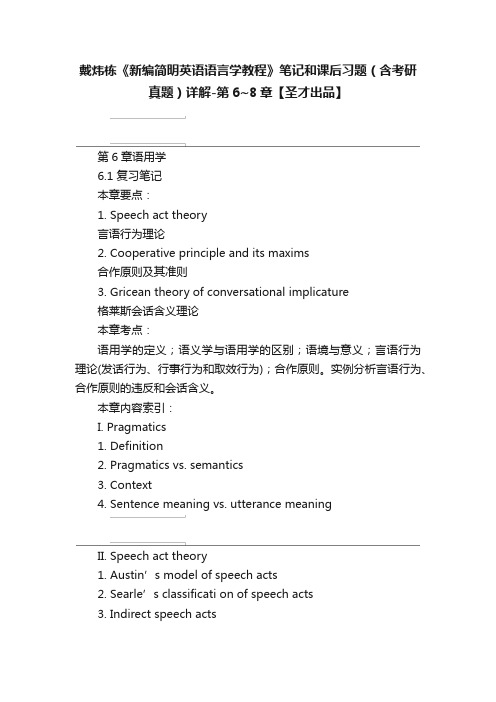
戴炜栋《新编简明英语语言学教程》笔记和课后习题(含考研真题)详解-第6~8章【圣才出品】第6章语用学6.1 复习笔记本章要点:1. Speech act theory言语行为理论2. Cooperative principle and its maxims合作原则及其准则3. Gricean theory of conversational implicature格莱斯会话含义理论本章考点:语用学的定义;语义学与语用学的区别;语境与意义;言语行为理论(发话行为、行事行为和取效行为);合作原则。
实例分析言语行为、合作原则的违反和会话含义。
本章内容索引:I. Pragmatics1. Definition2. Pragmatics vs. semantics3. Context4. Sentence meaning vs. utterance meaningII. Speech act theory1. Austin’s model of speech acts2. Searle’s classificati on of speech acts3. Indirect speech actsIII. Principle of conversation1. Cooperative Principle and its Maxims2. Violation of the MaximsIV. Conversational Implicature1. Definition2. Characteristics of Conversational Implicature(1) Calculability.(2) Cancellability(3) Non-detachability(4) Non-conventionality.V. Cross-cultural Pragmatic FailureI. Pragmatics(语用学)【考点:名词解释,与语义学的关系】1. Definition(定义)It is the study of how speakers of a language use sentences to effect successful communication.它是研究某一语言的言者是如何利用句子成功进行交际的。
戴炜栋《新编简明英语语言学教程》(第2版)笔记和课后习题(含考研真题)详解(第1章 导 言——第3章
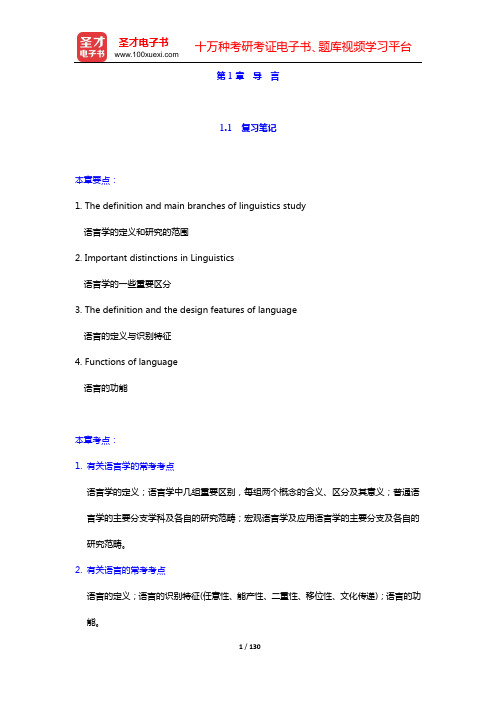
第1章导言1.1 复习笔记本章要点:1. The definition and main branches of linguistics study语言学的定义和研究的范围2. Important distinctions in Linguistics语言学的一些重要区分3. The definition and the design features of language语言的定义与识别特征4. Functions of language语言的功能本章考点:1. 有关语言学的常考考点语言学的定义;语言学中几组重要区别,每组两个概念的含义、区分及其意义;普通语言学的主要分支学科及各自的研究范畴;宏观语言学及应用语言学的主要分支及各自的研究范畴。
2. 有关语言的常考考点语言的定义;语言的识别特征(任意性、能产性、二重性、移位性、文化传递);语言的功能。
本章内容索引:I. The definition of linguisticsII. The scope of linguistics1. Micro-linguistics2. Macro-linguisticsIII. Some important distinctions in linguistics1. Descriptive vs. Prescriptive2. Synchronic vs. Diachronic3. Speech vs. Writing4. Langue vs. Parole5. Competence vs. Performance6. Traditional Grammar vs. Modern Linguistics IV. The definition of languageV. The design features of language1. Arbitrariness2. Productivity3. Duality4. Displacement5. Cultural Transmission6. InterchangeabilityVI. Functions of language1. Main functions2. Basic functions3. MacrofuntionsI. The definition of linguistics(语言学的定义)Linguistics is generally defined as the scientific study of language.It is a scientific study because it is based on the systematic investigation of linguistic data, conducted with reference to some general theory of language structure.语言学通常被定义为对语言进行科学性研究的学科。
戴炜栋《新编简明英语语言学教程》(第2版)课后习题详解(第10章语言习得——第12章语言与大脑)

戴炜栋《新编简明英语语⾔学教程》(第2版)课后习题详解(第10章语⾔习得——第12章语⾔与⼤脑)第10章语⾔习得1. Try to explain the terms:Language AcquisitionLanguage Acquisition DeviceCritical Period HypothesisKey: (1) Language acquisition refers to the child’s acquisition of his mother tongue, i.e. how the child comes to understand and speak the language of his community.(2) Chomsky referred to children’s innate ability to learn their native language as Language Acquisition Device (LAD). The LAD was described as an imaginary “black box”existing somewhere in the human brain. The “black box”is said to contain principles that are universal to all human languages. Children need access to the samples of a natural language to activate the LAD, which enables them to discover his language’s structure by matching the innate knowledge of basic grammatical system to that particular language.(3) This hypothesis was put forward by Eric Lenneberg in 1967. It states that children have a special propensity for acquiring language, especially between the ages of 2 to 13. There are two versions of CPH. While the strong one suggests that children must acquire their first language by puberty or they will never be able to learn from subsequent exposure, the weak one holds that language learning will be more difficult and incomplete after puberty.2. Among the language acquisition theories mentioned in this chapter, which one do you think is more reasonable and convincing? Explain why.Key:There are three language acquisition theories mentioned in this chapter. Traditional behaviorists view language as behavior and believe that language learning is simply a matter of imitation and habit formation. According to innatist view, human beings are biologically programmed for language and that the language develops in the child just as other biological functions such as walking. The interactionist view holds that language develops as a result of the complex interplay between the human characteristics of the child and the environment in which the child develops.Behaviorists view sounds reasonable in explaining the routine aspects, the innatist accounts most plausible in explaining children’s acquiring complex system, and the interactionist description convincing in understanding how children learn and use the language appropriately from their environment.In my opinion, I think that the interactionist view is more reasonable, because environment plays a great role in our acquisition of language. Only when conversations provide the right level of language that children are capable of processing can they facilitate children’s language acquisition, otherwise, it is insufficient for children to learn the language’s structure.(答案不唯⼀,⾔之成理即可)3. Which of the following statements are TRUE and which are FALSE? Why?a. All normal children have equal ability in learning their first language.b. It is easy for parents to teach their children grammar.c. The young child is not taught to speak, or to understand his language. There isno formal learning of grammar or pronunciation practice.d. At first children do not inflect nouns or verbs.e. Children learn their native language well whenever they start and whateverkinds of language samples they receive.f. The ability to learn a second language as an adult may vary considerablybetween individuals.g. For a child to acquire his mother tongue the most basic requirement is that hehears people speaking this language. He will then begin to learn the language.h. Phonology and grammar are finite, tightly structured systems, the child mustmaster them before puberty in order to be a native speaker of the language. Key: a) True. (Language acquisition device explains it.)b) False. (Grammatical development is partly a matter of growing “competence”and partly a matter of increasing “performance”capacity. Some subtle grammatical distinctions may not be mastered much before the age of ten.)c) True. (Young children acquire their mother tongue.)d) True (At the beginning, children’s acquisition focuses on content.)e) False (Critical Period Hypothesis can explain it.)f) True (Different individuals are exposed to different language learning environment; and their learning abilities are affected by different motivation and personalities.)g) True. (When a child begins acquire his mother tongue, he must be exposed to the language environment.)h) True. (Critical Period Hypothesis can explain it.)4. Each of the following utterances comes from the speech of a child in thetwo-word state. Identify the semantic relation expressed by each of these utterances.Key:a) The child’s utterance “Jimmy swim”may have a lot of different semantic meanings such as “Jimmy can swim”, “Jimmy swims”, or “Jimmy is swimming”. For children have no concepts of tense at this age, he/she only use two words “Jimmy swim”to express his/her intended meaning “Jimmy is swimming?”, a interrogative question.b) The semantic meaning of “Ken book”is “Ken’s book”. The part which is omitted by the child is the possessive case of Ken, but it still can imply the meaning of “Ken’s book”.c) When the child sees his/her father in the office, the child may say “Daddy office”, which means “Daddy is at his office”.d) By omitting the subject of the sentence “You”, the child expresses the meaning using “Push baby”. Obviously the meaning is synonymous with “You push the babies”.e) When the child sees his/her mother reading, he/she simply says “Mommy read” instead of using the present tense.第11章第⼆语⾔习得1. To what extent is second language learning similar to first language learning? Can you list some proof from your own learning experiences?Key: Theoretically the new findings and advances in first language acquisition especially in learning theories and learning process are illuminating in understanding second language acquisition. The techniques used to collect and analyze data in first language acquisition also provide insights and perspectives in the study of second language acquisition. For example, we started to learn our native language from listening, then speaking.(答案不唯⼀,⾃由发挥即可)2. Try to observe yourself and pay attention to your own learning experience, what conclusions are you more likely to use or depend on Chinese in learning and using English?Key: When I first contacted with English, I often used Chinese to help me learn it. According to the pronunciation of some English words, I picked an approximate accent to mark an English word. Chinese played a great role as interlanguage in such an English learning process. Those Chinese markers helped me remember the English words better.(答案不唯⼀,⾃由发挥即可)。
戴炜栋《新编简明英语语言学教程》(第2版)笔记和课后习题考研真题
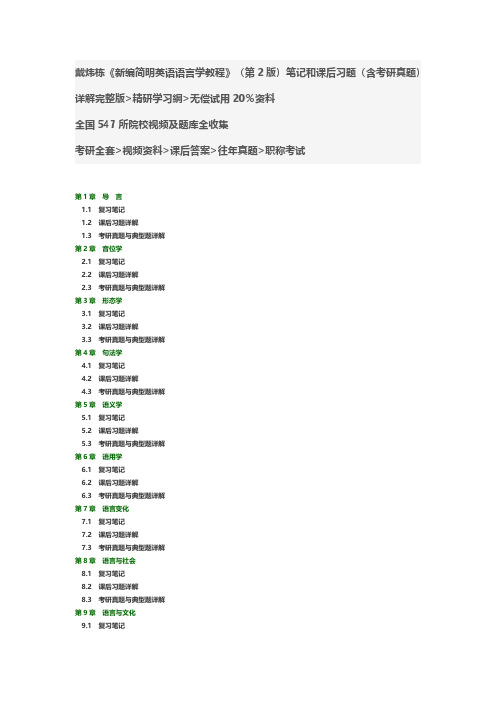
戴炜栋《新编简明英语语言学教程》(第2版)笔记和课后习题(含考研真题)详解完整版>精研学习䋞>无偿试用20%资料
全国547所院校视频及题库全收集
考研全套>视频资料>课后答案>往年真题>职称考试
第1章导言
1.1复习笔记
1.2课后习题详解
1.3考研真题与典型题详解
第2章音位学
2.1复习笔记
2.2课后习题详解
2.3考研真题与典型题详解
第3章形态学
3.1复习笔记
3.2课后习题详解
3.3考研真题与典型题详解
第4章句法学
4.1复习笔记
4.2课后习题详解
4.3考研真题与典型题详解
第5章语义学
5.1复习笔记
5.2课后习题详解
5.3考研真题与典型题详解
第6章语用学
6.1复习笔记
6.2课后习题详解
6.3考研真题与典型题详解
第7章语言变化
7.1复习笔记
7.2课后习题详解
7.3考研真题与典型题详解
第8章语言与社会
8.1复习笔记
8.2课后习题详解
8.3考研真题与典型题详解
第9章语言与文化
9.1复习笔记
9.2课后习题详解
9.3考研真题与典型题详解第10章语言习得
10.1复习笔记
10.2课后习题详解
10.3考研真题与典型题详解第11章第二语言习得
11.1复习笔记
11.2课后习题详解
11.3考研真题与典型题详解第12章语言与大脑
12.1复习笔记
12.2课后习题详解
12.3考研真题与典型题详解。
戴炜栋简明语言学教程配套笔记
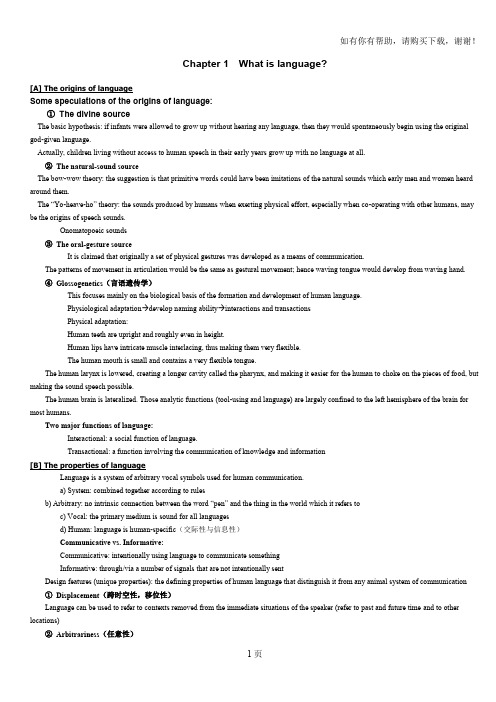
Chapter 1 What is language?[A] The origins of languageSome speculations of the origins of language:①The divine sourceThe basic hypothesis: if infants were allowed to grow up without hearing any language, then they would spontaneously begin using the original god-given language.Actually, children living without access to human speech in their early years grow up with no language at all.②The natural-sound sourceThe bow-wow theory: the suggestion is that primitive words could have been imitations of the natural sounds which early men and women heard around them.The “Yo-heave-ho” theory: the sounds produced by humans when exerting physical effort, especially when co-operating with other humans, may be the origins of speech sounds.Onomatopoeic sounds③The oral-gesture sourceIt is claimed that originally a set of physical gestures was developed as a means of communication.The patterns of movement in articulation would be the same as gestural movement; hence waving tongue would develop from waving hand.④Glossogenetics(言语遗传学)This focuses mainly on the biological basis of the formation and development of human language.Physiological adaptation→develop naming ability→interactions and transactionsPhysical adaptation:Human teeth are upright and roughly even in height.Human lips have intricate muscle interlacing, thus making them very flexible.The human mouth is small and contains a very flexible tongue.The human larynx is lowered, creating a longer cavity called the pharynx, and making it easier for the human to choke on the pieces of food, but making the sound speech possible.The human brain is lateralized. Those analytic functions (tool-using and language) are largely confined to the left hemisphere of the brain for most humans.Two major functions of language:Interactional: a social function of language.Transactional: a function involving the communication of knowledge and information[B] The properties of languageLanguage is a system of arbitrary vocal symbols used for human communication.a) System: combined together according to rulesb) Arbitrary: no intrinsic connection between the word “pen” and the thing in the world which it refers toc) Vocal: the primary medium is sound for all languagesd) Human: language is human-specific(交际性与信息性)Communicative vs. Informative:Communicative: intentionally using language to communicate somethingInformative: through/via a number of signals that are not intentionally sentDesign features (unique properties): the defining properties of human language that distinguish it from any animal system of communication①Displacement(跨时空性,移位性)Language can be used to refer to contexts removed from the immediate situations of the speaker (refer to past and future time and to other locations)②Arbitrariness(任意性)There is no logical or natural connection between a linguistic form (either sound or word) and its meaning.While language is arbitrary by nature, it is not entirely arbitrary.a) echo of the sounds of objects or activities: onomatopoeic wordsb) some compound words③Productivity(能产性,创造性)Language is productive in that it makes possible the construction and interpretation of new signals by its users. (Creativity or open-endedness)④Cultural transition(文化传递性)While human capacity for language has a genetic basis (everyone was born with the ability to acquire a language), the details of any language system are not genetically transmitted, but instead have to be taught and learnt.⑤Discreteness(可分离性)Each sound in the language is treated as discrete.⑥Duality(双重结构性,两重性或二元性)Language is organized at two levels or layers simultaneously. The lower or basic level is a structure of sounds which are meaningless. The higher level is morpheme or word (double articulation)The above six properties may be taken as the core features of human language.Vocal-auditory channel, reciprocity, specialization, non-directionality, or rapid fade, these properties are best treated as ways of describing human language, but not as a means of distinguishing it from other systems of communication.[C] The development of written language①pictograms & ideograms(象形文字和表意文字)Pictogram: when some of the pictures came to represent particular images in a consistent way, we can begin to describe the product as a form of picture-writing, or pictograms.Ideogram: the picture developed as more abstract and used other than its entity is considered to be part of a system of idea-writing, or ideogram Hieroglyph: 古埃及象形文字②Logograms(语标书写法)When symbols come to be used to represent words in a language, they are described as examples of word-writing, or logograms.“Arbitrariness”—a writing system which was word-based had come into existence.Cuneiform--楔形文字—the Sumerians (5000 and 6000 years ago)Chinese is one example of its modern writing system.Advantages: two different dialects can be based on the same writing system.Disadvantages: vast number of different written forms.③Syllabic writing(音节书写法)When a writing system employs a set of symbols which represent the pronunciations of syllables, it is described as syllabic writing.The Phoenicians: the first human beings that applied the full use of a syllabic writing system (ca 1000 BC)④Alphabetic writing(字母书写法)Semitic languages (Arabic and Hebrew): first applied this ruleThe Greeks: taking the inherently syllabic system from the Phoenicians via the RomansLatin alphabet and Cyrillic alphabet (Slavic languages)⑤Rebus writingRobus writing evolves a process whereby the symbol used for an entity comes to be used for the sound of the spoken word used for that entity.Chapter 2 What is linguistics?[A] The definition of linguisticsLinguistics is generally defined as the scientific study of language.Process of linguistic study:①Certain linguistic facts are observed, generalization are formed;②Hypotheses are formulated;③Hypotheses are tested by further observations;④ A linguistic theory is constructed.Language is a system of arbitrary vocal symbols used for human communication.[B] The scope of linguisticsGeneral linguistics: the study of language as a wholePhonetics: the general study of the characteristics of speech sounds (or the study of the phonic medium of language) (How speech sounds are produced and classified)Phonology: is essentially the description of the systems and patterns of speech sounds in a language. (How sounds form systems and function to convey meaning)Morphology: the study of the way in which morphemes are arranged to form words (how morphemes are combined to form words)Syntax: the study of those rules that govern the combination of words to form permissible sentences (how morphemes and words are combined to form sentences)Semantics: the study of meaning in abstractionPragmatics: the study of meaning in context of useSociolinguistics: the study of language with reference to societyPsycholinguistics: the study of language with reference to the workings of the mindApplied linguistics: the application of linguistics principles and theories to language teaching and learningAnthropological linguistics, neurological linguistics; mathematical linguistics; mathematical linguistics; computational linguistics[C] Some important distinctions in linguistics①Prescriptive vs. Descriptive②Synchronic vs. DiachronicThe description of a language at some point in time;The description of a language as it changes through time.③Speech and writingSpoken language is primary, not the written④Langue and paroleProposed by Swiss linguists F. de Sausse (sociological)Langue: refers to the abstract linguistic system shared by all the members of a speech communityParole: refers to the realization of langue in actual use⑤Competence and performanceProposed by the American linguist N. Chomsky (psychological)Competence: the ideal user’s knowledge of the rules of his language。
戴炜栋《新编简明英语语言学教程》(第2版)笔记和课后习题(含考研真题)详解(第7章语言变化——第9
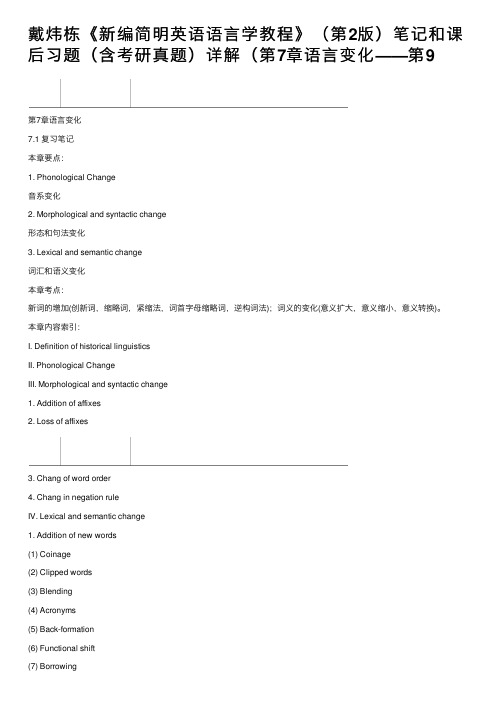
戴炜栋《新编简明英语语⾔学教程》(第2版)笔记和课后习题(含考研真题)详解(第7章语⾔变化——第9第7章语⾔变化7.1 复习笔记本章要点:1. Phonological Change⾳系变化2. Morphological and syntactic change形态和句法变化3. Lexical and semantic change词汇和语义变化本章考点:新词的增加(创新词,缩略词,紧缩法,词⾸字母缩略词,逆构词法);词义的变化(意义扩⼤,意义缩⼩,意义转换)。
本章内容索引:I. Definition of historical linguisticsII. Phonological ChangeIII. Morphological and syntactic change1. Addition of affixes2. Loss of affixes3. Chang of word order4. Chang in negation ruleIV. Lexical and semantic change1. Addition of new words(1) Coinage(2) Clipped words(3) Blending(4) Acronyms(5) Back-formation(6) Functional shift(7) Borrowing2. Loss of words3. Semantic Changes(1) Semantic broadening(2) Semantic Narrowing(3) Semantic shiftV. Some recent trends1. Moving towards greater informality2. The influence of American English3. The influence of science and technology(1) Space travel(2) Computer and internet language(3) EcologyVI. Causes of language changeI. Definition of historical linguistics(历史语⾔学的定义)Historical linguistics, as a branch of linguistics, is mainly concerned with both the description and explanation of language changes that occurred over time.历史语⾔学是语⾔学的⼀个分⽀,主要研究语⾔随着时间的变化⽽产⽣的变化与变化的原因。
(NEW)戴炜栋《新编简明英语语言学教程》(第2版)笔记和课后习题(含考研真题)详解
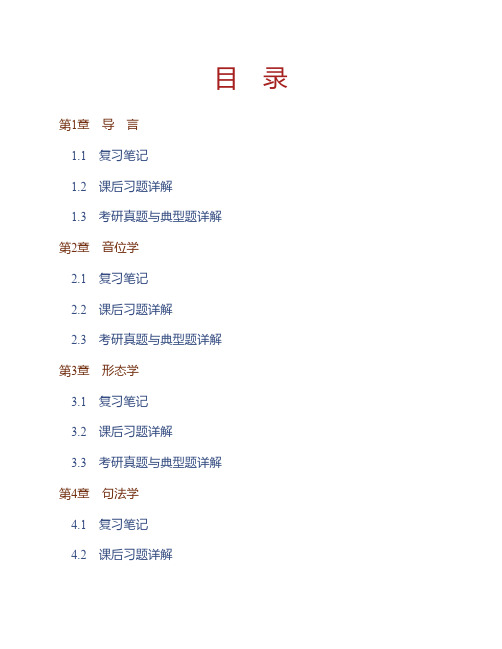
目 录第1章 导 言1.1 复习笔记1.2 课后习题详解1.3 考研真题与典型题详解第2章 音位学2.1 复习笔记2.2 课后习题详解2.3 考研真题与典型题详解第3章 形态学3.1 复习笔记3.2 课后习题详解3.3 考研真题与典型题详解第4章 句法学4.1 复习笔记4.2 课后习题详解4.3 考研真题与典型题详解第5章 语义学5.1 复习笔记5.2 课后习题详解5.3 考研真题与典型题详解第6章 语用学6.1 复习笔记6.2 课后习题详解6.3 考研真题与典型题详解第7章 语言变化7.1 复习笔记7.2 课后习题详解7.3 考研真题与典型题详解第8章 语言与社会8.1 复习笔记8.2 课后习题详解8.3 考研真题与典型题详解第9章 语言与文化9.1 复习笔记9.2 课后习题详解9.3 考研真题与典型题详解第10章 语言习得10.1 复习笔记10.2 课后习题详解10.3 考研真题与典型题详解第11章 第二语言习得11.1 复习笔记11.2 课后习题详解11.3 考研真题与典型题详解第12章 语言与大脑12.1 复习笔记12.2 课后习题详解12.3 考研真题与典型题详解第1章 导 言1.1 复习笔记本章要点:1. The definition and main branches of linguistics study语言学的定义和研究的范围2. Important distinctions in Linguistics语言学的一些重要区分3. The definition and the design features of language语言的定义与识别特征4. Functions of language语言的功能本章考点:1. 有关语言学的常考考点语言学的定义;语言学中几组重要区别,每组两个概念的含义、区分及其意义;普通语言学的主要分支学科及各自的研究范畴;宏观语言学及应用语言学的主要分支及各自的研究范畴。
- 1、下载文档前请自行甄别文档内容的完整性,平台不提供额外的编辑、内容补充、找答案等附加服务。
- 2、"仅部分预览"的文档,不可在线预览部分如存在完整性等问题,可反馈申请退款(可完整预览的文档不适用该条件!)。
- 3、如文档侵犯您的权益,请联系客服反馈,我们会尽快为您处理(人工客服工作时间:9:00-18:30)。
第10章语言习得10.1 复习笔记本章要点:1. Theories of child language acquisition儿童语言习得的理论2. Cognitive development in child language development儿童语言发展中的认知因素3. Language environment and the Critical Period Hypothesis语言环境和临界期假说4. Stages in child language development儿童语言发展的阶段5. Atypical development非典型发展本章考点:行为主义者预言习得观;语法天生主义者的习得观;语言环境和临界期假说。
本章内容索引:I. Theories of child language acquisition1. A behaviourist view of language acquisition2. An innatist view of language acquisition3. An interactionist view of language acquisitionII. Cognitive development in child language developmentIII. Language environment and the Critical Period HypothesisIV. Stages in child language development1. Phonological development2. Vocabulary development3. Grammatical development4. Pragmatic developmentV. Atypical developmentI. Theories of child language acquisition(儿童语言习得的理论)1. A behaviourist view of language acquisition(行为主义者的语言习得观)(1) Main content(主要观点)①A behaviourist view of language acquisition Traditional behaviorists view language as behavior and believe that language learning is simply a matter of imitation and habit formation. A child imitates the sounds and patterns of the people around him; people recognize the child’s attempts and reinforce the attempts by responding differently, the child repeats the right sounds or patterns to get the reward(reinforcement)②So imitation and practice are preliminary, discrimination and generalization are key to language development in this theory. Imitation: word for word repetition of all or part of an utterance.①传统的行为主义者把语言看作是行为,并且相信语言学习仅仅只是一个模仿和习惯形成的问题。
儿童模仿其周围的人的声音和模式;人们识别儿童的努力,并且通过不同的反应来强化这种努力,儿童重复正确的语音或模式来获得奖励(强化)。
②在这个理论中,模仿和实践是基本的,进行区别和总结对于语言的发展至关重要。
(2) Significance(意义)The behaviorist theory of child language acquisition offers a reasonable account of how children acquire some of the regular and routine aspects of the language, yet how they acquire more complex grammatical structures of the language requires a different explanation.行为主义者关于儿童语言习得的理论为儿童是如何习得一些语言规则和惯例的方面提供了合理的解释。
然而,要了解他们是如何习得更为复杂的语言语法结构的则需要一个不同的解释。
2. An innatist view of language acquisition(语法天生主义者的语言习得观)【考点:名词解释,概念阐述】(1) Definition(定义)Noam Chomsky claims that human beings are biologically programmed for language and that the language develops in the child just as other biological functions, such as walking.诺姆·乔姆斯基声称人天生就具有语言能力,而且语言的发展是和儿童的其他生物功能的发展一样的,如行走。
(2) Development(发展)Originally Chomsky referred to this innate ability as Language Acquisition Device, (also known as LAD).Later Chomsky prefers this innate endowment as Universal Grammar(UG) and holds that if children are pre-equipped with UG, then what they have to learn is the ways in which their own language makes use of these principles and the variations on those principles which may exist in the particular language they are learning.最初,乔姆斯基把这种天生的能力称为语言习得机制。
后来,乔姆斯基偏向于将这种内在天赋称为普遍语法(UG),并且认为,如果儿童天生具备UG,那么,他们所要学习的,就是他们的语言运用这些原则的方式和他们正在学习的特定语言中可能存在的那些原则的变体。
(3) Main content(主要观点)The innatists argue that children could not discover the rules of reflexive pronouns by trial and error. Instead children’s acquisition of these grammatical rules is guided by principles of an innate UG. Different languages have different rules about reflexives, and children seem to be able to “know” the rules by being exposed to a limited number of examples.语法天生主义者认为,儿童并不能通过试用和错误发现反身代词的规则。
相反,儿童对于这些语法规则的习得是受内在UG原则的指导的。
不同的语言有不同的反身代词规则,而且通过接触有限的例子,儿童似乎就能够“知道”这些规则。
3. An interactionist view of language acquisition(互动主义者的语言习得观)The interaetionist view holds that language develops as a result of the complex interplay between the human characteristics of the child and the environment in which the child develops. Integrated with the innatist view,the interactionist further claims that the modi fied language which is suitable for the child’s capability is crucial in his language acquisition.互动主义者观认为语言的发展是儿童身上人类的特点与儿童发展所在的环境之间复杂的相互作用的结果。
与语法天生主义者观构成一个整体,互动主义者进一步声称适合儿童能力的经过限定的语言在他的语言习得中是至关重要的。
II. Cognitive factors in child language development(儿童语言发展中的认知因素)The cognitive factors relate to language acquisition mainly in two ways.1. Language development is dependent on both the concepts children form about the world and what they feel stimulated to communicate at the early and later stages of their language development.2. The cognitive factors determine how the child makes sense of the linguistic system himself instead of what meanings the child perceives and expresses. Many careful studies of children’s acquisition sequences and errors in various languages have revealed that children have some “operating principles” for making sense of language data.认知因素与语言习得主要在两种方式上相关。
